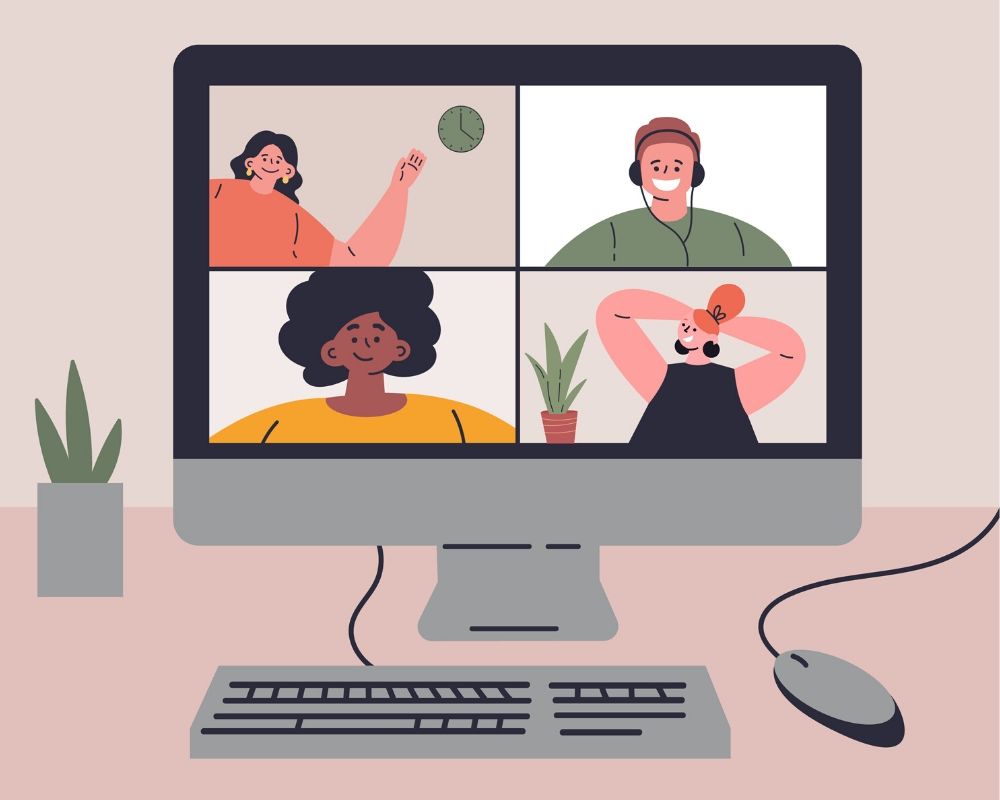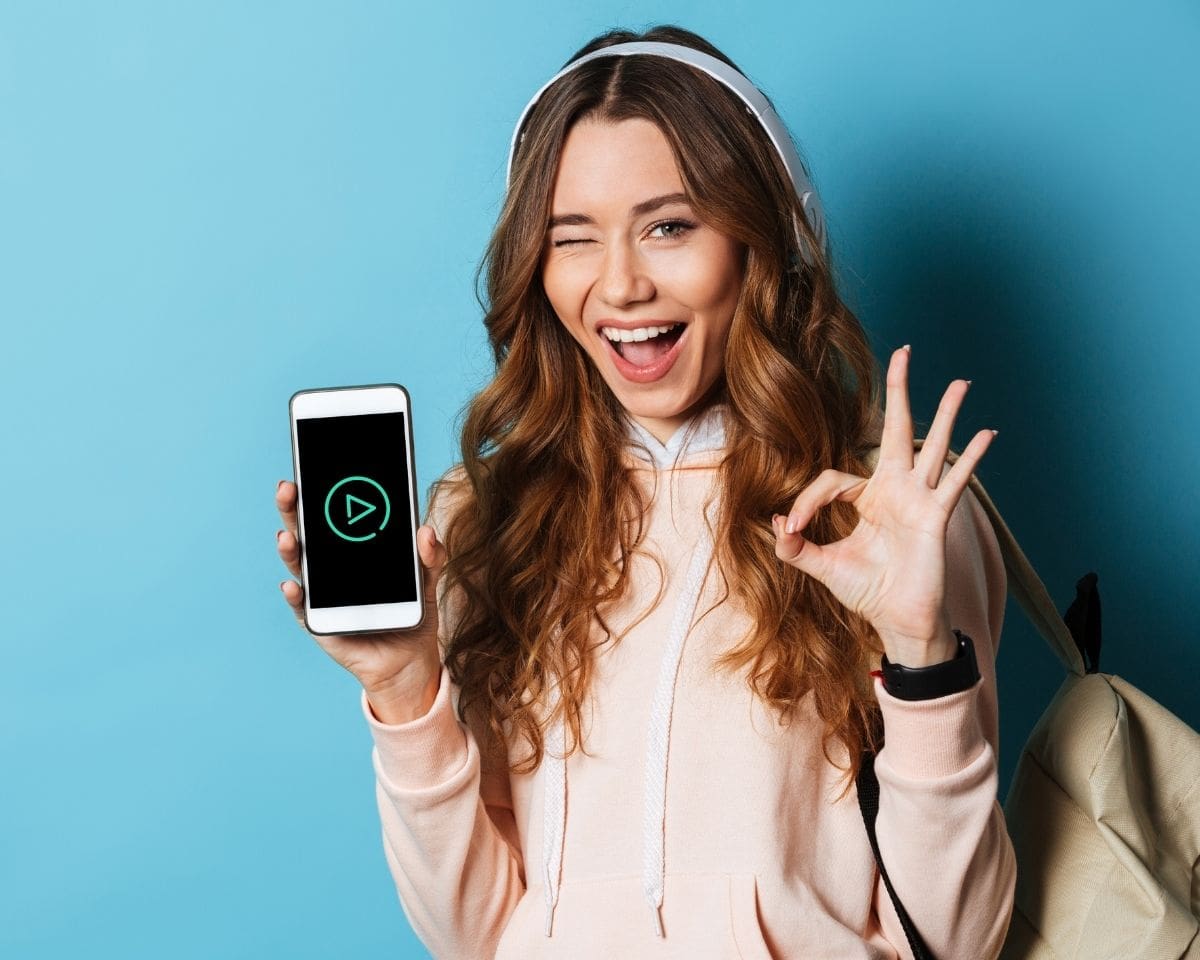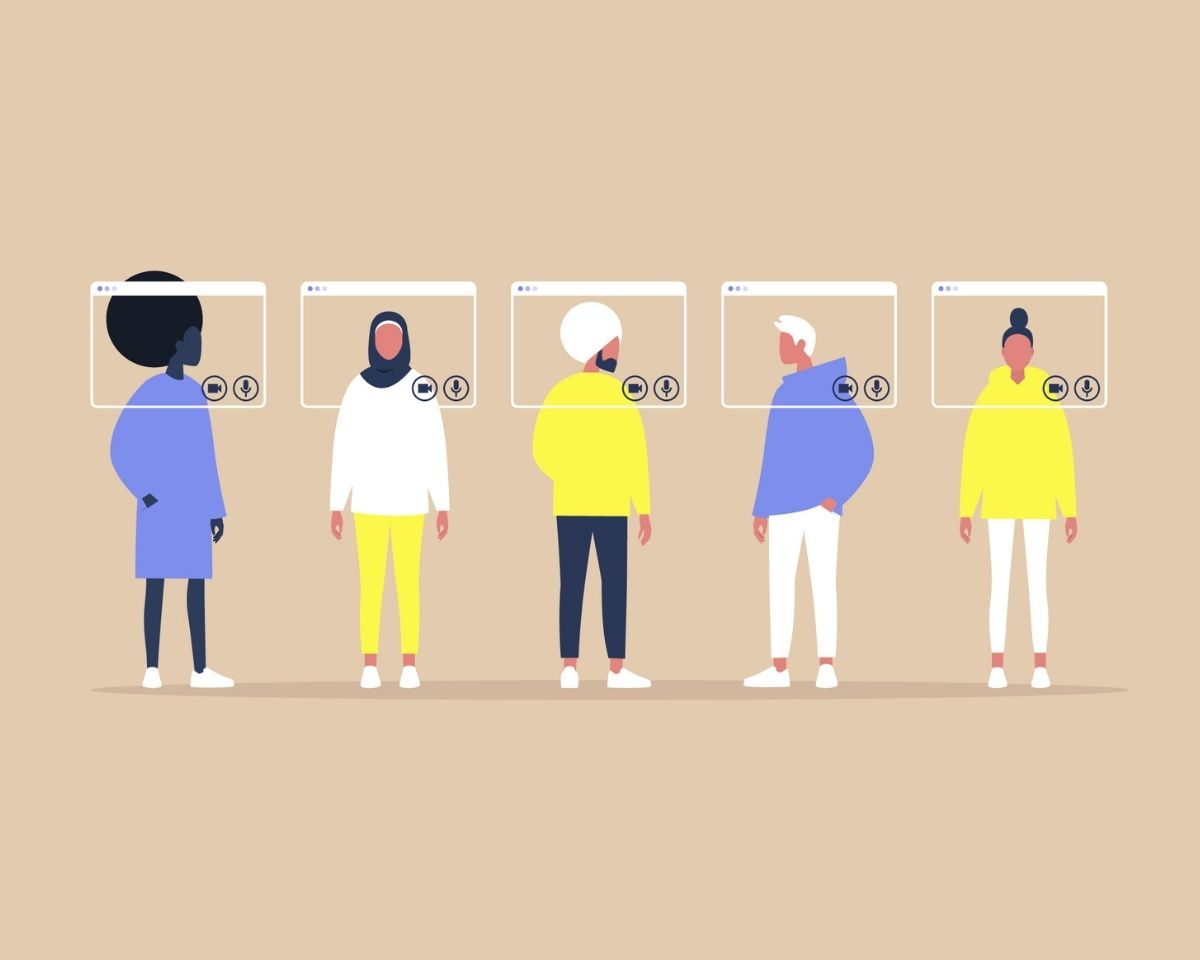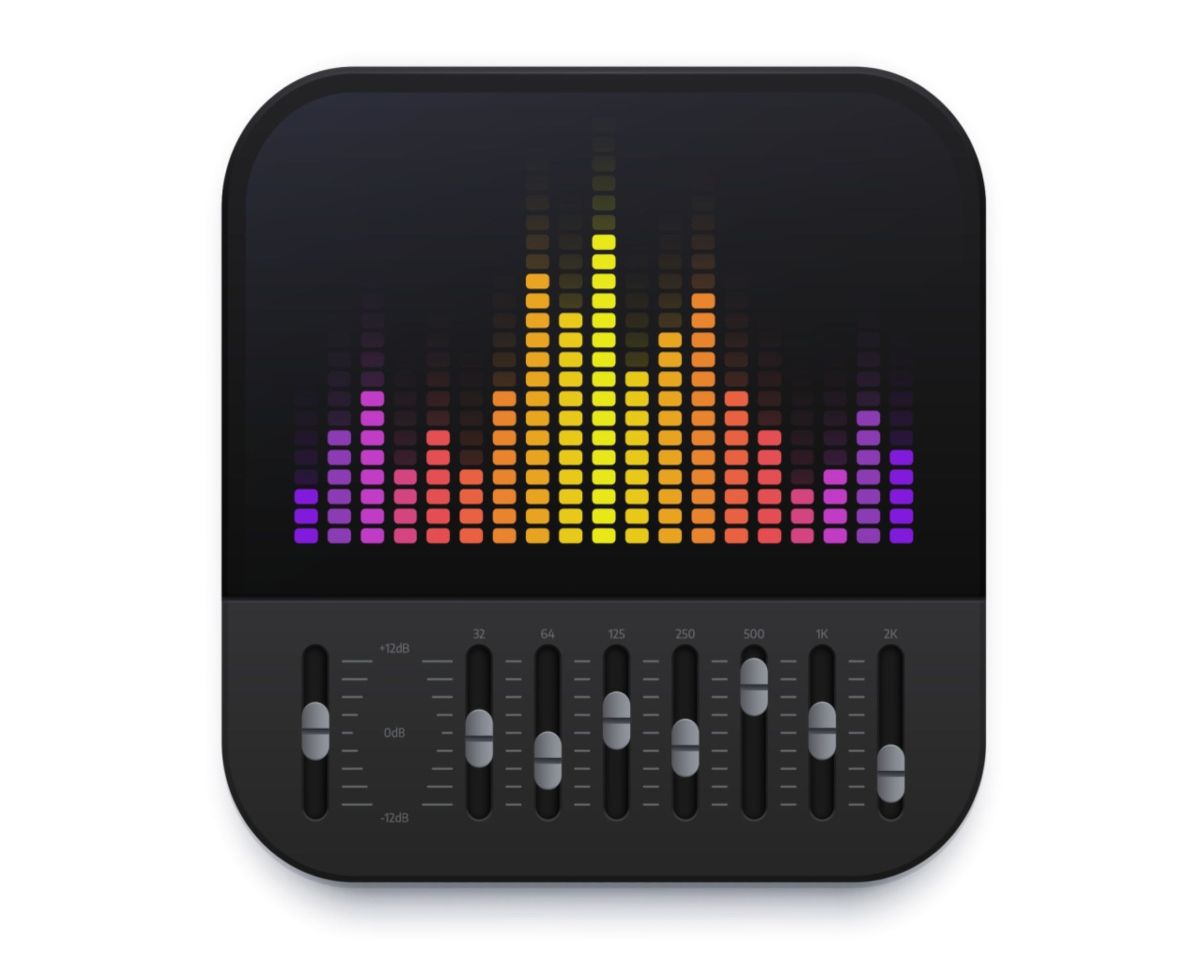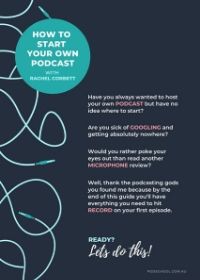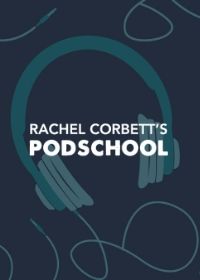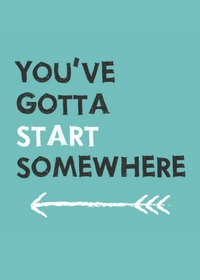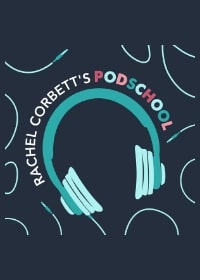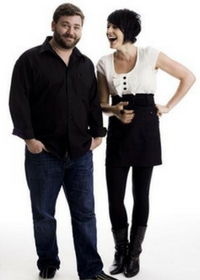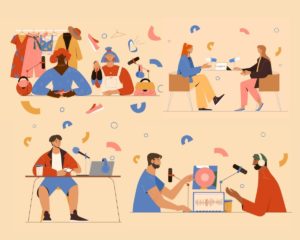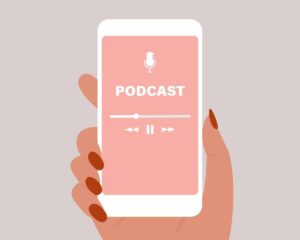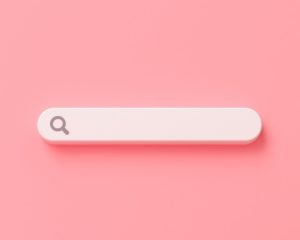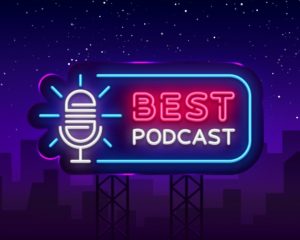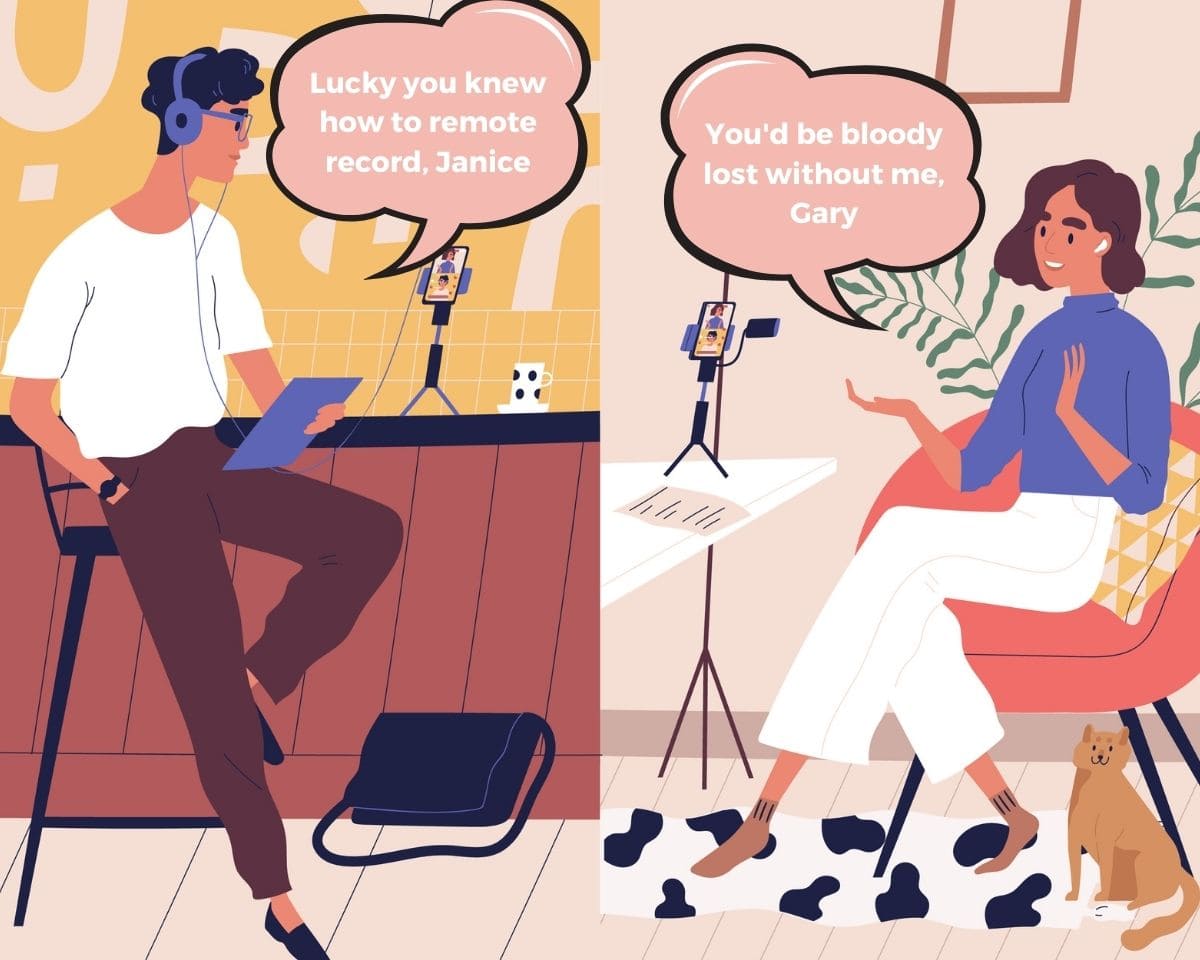
Can you record a high-quality podcast when you’re not in the same room as someone?
Recording a podcast with people in different locations gives you the flexibility to bring guests on your show from all over the world.
It also means you and your co-host can keep releasing episodes even if one of you goes away or if your chosen co-host lives on the other side of the world.
So how do you record your podcast with people in different locations without compromising on the quality of your show?
How do you record a podcast remotely?
There are a number of different ways to record your podcast remotely and the option that’s right for you will depend on the technology you have access to and how experienced the people on your show are with recording audio.
If you’re remote recording interviews you can get away with having your guest at a lower audio quality than you.
But if you’re hosting with a co-host remotely you want to make sure you’re recording similar audio quality so there’s no power imbalance and so it sounds, ideally, like you’re in the same room.
So, what are your options?
Option 1: Recording each person locally and matching up the audio in the edit
Option 2: Recording your show via a remote recording platform
Option 3: Recording your show via video conferencing software e.g. Zoom or Skype
Option 4: Using a mixer to record guests via phone
Now let’s look at what you need for each option and the benefits and disadvantages of each…
Option 1: Recording audio locally
This is the most complex option and one you should use only if each person speaking has a good audio setup and is very comfortable with recording audio.
If that’s not you or your guest, I’d advise moving to the next option.
What you need to record audio locally
- Audio editing software e.g. Audition or a recording device e.g. Zoom H6
- A good microphone for everyone on the show unless you want a high-quality recording of crappy audio (Tip: you don’t)
- A good recording environment at both ends i.e. away from tiles and hard, reflective surfaces
- Additional software like Skype or Zoom so you can hear (and see) each other while you record
Benefits
- If you’re both recording using good quality podcast microphones and you’re both in a good recording space, this will yield excellent audio quality
- It allows each person to use an audio setup they’re comfortable with
Disadvantages
- It requires technical knowledge and equipment so it’s not something you’re likely to be able to do with guests unless they have a mic and a good understanding of recording audio
- You need to match up the tracks manually at the end, which can be a bit fiddly (so don’t forget to clap when you start recording so you’ve got a visual marker that will help you line things up)
- You need to run additional software to see and hear each other e.g. Skype
- There are plenty of remote recording websites out there now that make this process a lot easier
Pro tip
- If you’re running Skype or Zoom at the same time so you can hear and see the person you’re talking to it’s likely some of the audio from your guest or co-host will ‘bleed’ out of your headphones and be picked up by your mic, which you don’t want. When I’m recording like this I use earbuds to listen to my guest or co-host then put over-ear headphones over the top and plug those into my portable recording device. That not only allows me to hear myself, which is important, but it helps cover up the sound of the Skype or Zoom audio
- If you’re used to being in the same room as your co-host it might be worth doing a few practice sessions before you go ‘live’ as being remote from someone means the conversational chemistry can sometimes be a little harder to nail so you have to find a new rhythm
Option 2: Record audio via a remote recording platform
Since podcasting has increased in popularity and the demand for simpler remote recording options has skyrocketed, platforms like Zencastr, Squadcast, Riverside.fm and Ringr have stepped in to make things easier.
Each of these apps or websites record each person where they are and sync up the tracks automatically so you don’t have to waste time clapping or lining things up in the edit.
This is a good option if everyone speaking on the podcast has a good-quality microphone.
What you need to record via a remote recording platform
- A good microphone at both ends
- A good recording environment at both ends
- A strong internet connection to prevent the conversation from dropping out
- A remote recording platform that ideally has video built-in (which most of them do) so you don’t have to run multiple programs
Benefits
- It’s a much simpler way of recording audio locally
- You can record high-quality audio without the need for a complex setup
- You don’t need to line up the audio tracks in the edit as this is done automatically
- The recording sessions are easy to set up and easy to share with a guest via email
- If your audio drops out because of poor connection this won’t affect the final recording because all audio is recorded locally
- You’ve got video and audio in a single program and most platforms also give you the option to record video as well
Disadvantages
- The quality of the experience is dependent on the strength of your internet connection. When you’re talking to a guest you’ve never met before a crappy connection can make things difficult because it can disrupt the rhythm of the conversation
Pro-Tip
- It’s always best to do a trial of each website and see which one produces the best results for you and is easiest for you to use
- If you only have access to guests with a phone and no microphone, recording via Ringr is probably the best option as it records your guest locally on their phone microphone rather via a phone line (which is the worst quality audio of all)
Option 3: Record audio via video conferencing platform
This is the option to go with if your guest doesn’t have a good quality microphone and you need to cover that up.
What you need to record via video conferencing software
- A good microphone for the host but if the guest has a good microphone too that will improve the end product
- A good recording environment at both ends
- A strong internet connection to prevent the conversation from dropping out
- If you’re recording using Skype and want more flexibility with the audio (the ability to split audio tracks) you’ll need an additional piece of software like eCamm
- Skype credit if you’re going to be making phone calls
Benefits
- People are familiar and comfortable with these programs so they won’t be intimidated by new software
- Audiences are used to hearing Skype-quality audio on podcasts because shows have been recording this way for years
- If you can only get a guest on the phone, Skype audio will be slightly better than phone audio
Disadvantages
- The quality of audio for your guest will be a lot lower than your audio quality so it won’t sound like you’re in the same room
- They’re video conferencing platforms first and foremost so they’re never going to yield audio that’s as high quality as other methods like remote recording platforms
Pro-Tip
- You can use this method to record high-quality audio for both guests if both people on the call have recording software like eCamm installed on their computer. If they do both people will record the call, split the tracks after the recording is done, discard the Skype call audio from both sessions and marry up the two high-quality audio files. These audio files won’t be perfectly matched so you’ll need to clap at the beginning of the recording to make it easier to line them up later.
Option 4: Record audio using a mixer
Most podcasters don’t have a mixer at home but if you do it can be an easier way to integrate phone calls and additional audio into your recording.
There are a lot of traditional mixers on the market, but there’s also a panel that’s been designed specifically for podcasters called the RODECaster Pro which can be great for a home studio.
Basically, a mixer just gives you more flexibility in terms of what you can record because it allows you to input audio directly into the device rather than faffing around with a bunch of different programs or editing things in later.
For example, if you’re recording a phone call, rather than using Skype you could just plug your phone into your mixer and the audio of the call will be picked up by your audio editing software.
What you need to record using a mixer
- A mixer (obviously)
- XLR microphones (these are different to USB microphones which plug directly into your computer)
- A good recording environment at both ends
Benefits
- You have much more flexibility over what you can record because you don’t have to run multiple programs or edit things in later
Disadvantages
- The equipment can be expensive and when you’re starting out you might not be able to justify the price
- This method limits you to the audio quality you can get from a phone which isn’t great
Pro-Tip
- If you’re looking to buy a mixer opt for one that gives you the ability to record audio on separate tracks. This will give you more control in the edit.
- If you’re recording people on the phone it’s always a good idea to record via an app that uses data e.g. WhatsApp audio, FaceTime, etc rather than a phone line. To most people’s ears, they won’t be able to tell the difference but you’ll get marginally better audio if you record this way rather than via a phone line
What remote recording option gives you the best audio quality?
To recap, when you’re recording your podcast remotely, this is the sliding scale of audio quality…
Best: Recording audio locally or via a remote recording platform
Providing everyone has a good audio setup and is recording in a good audio environment you can record a show that sounds like everyone was in the same room even if you’re miles apart.
Recording audio remotely via an app e.g. WhatsApp Facetime Audio
Most people’s ears might not pick up the difference but in my experience recording via apps/data gives you marginally better audio quality than audio recorded over a phone line.
Worst: Recording audio remotely via a phone line
The quality of this audio is dependent on reception and whether people move around so in the worst circumstances it can be really bad. If this is the only option you have I’d advise doing some research on how to clean up phone audio in your editing software after the call is recorded so you can make sure it sounds as good as it possibly can.
Got a burning question you’d like answered on the podcast? Send me an email.
Want to start your own podcast but need a little help? Download my “How To Start A Podcast” guide or sign up for my online podcasting course, PodSchool.
Hello there. My goodness, hasn't it been awhile since we've spoken to each other! There's been a lot going on in the world and I certainly didn't anticipate the next time I would speak to you would be a time when we were all hiding from each other and nobody could get their hands on any toilet paper. What a world we live in. But since that is what's happening at the moment, I'm getting a huge amount of questions regarding remote recording and recording your podcast separately, since none of us can be in the same room together as each other anymore. Now there are a lot of different options and I thought I would do a bumper remote recording episode and take you through all of the options that you have, the benefits and the disadvantages of each. And then a bit of a sliding scale of audio quality, so you can really understand what method of remote recording gives you the best quality all the way down to what the worst quality is. I must note, though, that these days even the worst quality isn't terrible, and often the decision you make about how to record your podcast remotely is going to depend on who you're doing the show with. So whether you've got a guest on the other end of the line who has absolutely no idea about technology or audio recording, and you don't want to freak them out by asking them to get microphones and download software and things, or if you are doing a show remotely with somebody that is really comfortable with audio and recording, that will make a huge difference.
So, let’s begin by going through the different options you have. The first is recording audio locally. So that means whoever is talking on your podcast is recording the audio where they are. This requires audio software or an audio recorder to record on to, but essentially you are getting really high-quality audio at both ends that you need to match up later. The next option you've got is recording using a website or app. There's a lot of apps and websites that have come out to try and help combat this issue of people being on a podcast and not being able to be in the same room together. Obviously, this has sprung up because there are a lot of interview shows around and it's a bit of a punish if you can only do interviews with people who you can be in the same room as, because you're probably going to want to talk to people all over the world. So, there are a lot of websites that have been created to try and help this problem. There are benefits and limitations to each and I will take you through a few that I've used, but this can be a really great way to record audio at both ends and kind of match it up in a much simpler way. Another option is recording via Skype. Of course, this has been done since the beginning of podcast time. You will have heard many, many shows, very professional shows, shows that are getting a lot of downloads using Skype as a way to record interviews. It's an acceptable way to have lower quality audio on your show. People are used to hearing Skype quality audio. So, while I'm a bit of a stickler for trying to get it to sound like people are in the same room, there is absolutely no reason, if you can only get somebody on Skype or call them via Skype, why you can't record them that way. And it's not like you're going to have people listening to the show going, "Oh, this is an audio outrage!" So, you can definitely record comfortably with Skype. And the last option is recording using a mixer or a portable recording device like a Zoom H6 that also operates like a mixer where basically you're using the phone audio and inputting that into the mixer or the recording device and then recording the audio that comes out of that device or mixer.
So those are the ways that you can do it. Let's go through what is required for each. The first is recording locally, so you're going to need a good microphone at both ends. The thing about recording locally is that you are recording in the best way you possibly can. So, the last thing you want to do is have a high-quality recording of crappy audio. So, if somebody is recording locally and they're just using the computer mic on their laptop, it is going to be a great recording of something that sounds utterly garbage. So, it's really important to have a really high-quality microphone. Again, that doesn't mean that it needs to be expensive, but it needs to be able to capture great audio because you're really going to be picking up everything when you're recording locally. You also need audio software or hardware at both ends so you could record directly into Adobe Audition using a USB mic or you could record onto a portable audio recorder like a Zoom. There are plenty of options. You just need to choose the one you are most familiar and comfortable with, but you will need that at both ends. So, both people will have to be responsible for recording their audio locally. You'll also need a bit of technical knowledge. So, this isn't something that you can spring on a guest you're having on your show and say, "By the way, do you mind downloading Audition and learning how to plug your inputs into that and record your own voice?" So, it's really an option you want to use if you've been separated from your co-host and you guys are having to work out a new way to do the show remotely. That can be a really great option, to record your audio locally so it sounds like you're in the same room or as close to that as it possibly can. You also need a way to hear each other. So, if you are recording locally, you're not going to be able to hear the other person on the other end so you need to link up via a program like Skype. That's often how I would do it. I would record locally; I would also run Skype at the same time. I would plug my earphones into my computer to listen to Skype and I would put those earbuds in then I might pop noise cancelling headphones over the top so that the audio doesn't bleed out from somebody talking to me on Skype and get picked up by the microphone and then plug those headphones into my Zoom where I record locally onto that audio. So, you still need a way to hear the person and you also need a way to see them. It's really hard when you're remotely recording with somebody to get that chemistry you have when you're in the same room together. So, anything that you can do to make it feel like you are in the same room is going to really help your show. So, you want to download Skype and be looking at each other rather than just talking to a blank screen and hearing their audio. It'll be much easier to get as more of that rhythm and chemistry if you can see them at the same time. And then you need a space that is good to record in at both ends. Both people are going to need to be in a space that is going to produce the best audio quality possible, i.e. not the toilet nor the kitchen. Avoid tiles and hard surfaces and record somewhere like your bedroom where you can pull the curtains across, get the doona out and get as many soft furnishings around as possible so the sound can be absorbed and you can get as high quality audio as possible in your recording. Some of the disadvantages are it obviously requires skills and knowledge, so you need to do it with a co-host. You also have to line up the audio so you want to remember to give a big clap at both ends so that you can have a little bit of a visual cue to line up the audio in your audio editing software. After that can be a bit fiddly. Once you start doing it and you've done it a few times, it becomes quite natural. But the first time you can feel like it's hard to get things in sync. But if you've got that clap mark, that just gives you a big peak in the audio waveform that allows you to line up your two tracks and then you can export those two things down into one file and edit on that. For some people that's not a picnic so it's just something to be mindful of. You also need to run the additional software to hear each other. So, it's a bit of faffing that needs to be done and it can be a bit hard to get the chemistry right when you're in different rooms. So, if you are used to being in the same room as your co-host, then don't be afraid to really try and do a couple of practice records just to get the rhythm right and get back into the groove.
The next option is using a remote recording platform. Now there are a bunch of apps and websites that have come out...Zencastr, Squadcast and Ringr are just a few and these have been designed to create that local audio experience. So, they record audio locally at both ends without you having to bother about clapping or worry about setting up two separate pieces of software at either end. This is a website or an app where you get linked up with your co-host or your guest within a room and you record the audio in there and it records each of you locally where you are and then uploads the file to the cloud. This is spectacular, in theory. In theory, this should work perfectly where the audio is just as good as it is if you are recording locally in software or hardware. Unfortunately, it doesn't always work perfectly but it's a really good option that can make things a lot easier if it works well. I always advise you just trial a few of these different websites and find out which one you really like and which one produces the best audio for you. You're going to still need a good microphone at both ends, a good Internet connection too, because often they can drop out. And the good thing about that, however, is that it often makes the conversational chemistry a bit jolting but, in my experience at least, usually the audio that's being recorded isn't affected by the glitches because it's being recorded locally. So, it's important to remember even if things are sounding a bit disjointed, if you can make out what your co-host or your interview subject is saying, sometimes you don't need to stop them to start again because it will actually be recording fine and you can just keep going. It's more annoying than anything. And again, these programs also require a good recording space. So, if you're talking to a guest, you just need to make sure that they're sitting in a space that's conducive to good audio quality. So, some of the benefits of remote recording platforms is it obviously records high quality audio without the need for complex setup or a lot of tech knowledge, although you do often need your own microphone. The website Squadcast is actually great because it is both video and audio. So you can see people within the platform rather than having to run Skype at the same time. So that's really a good way to use just one piece of software or one website without having to open up a whole bunch of different applications, which can be a bit annoying. It's also really easy to send a link to people, so you just open up the room that you want to record in and then you can even invite people via email or you just send them a link and they literally just click on it and pop in there. So, it's very easy if you're dealing with people who aren't used to setting these kinds of things up. You don't have to clap when you press record. It records immediately at the exact same second at both locations or more than two locations if you're recording multiple people. So that means when you drag those individual files into your audio editing software, you don't have to line them up. You just bring them up to the front of your multi-session and they are all lined up, ready to go at exactly the right spot, which is awesome. Zencastr is an audio-only platform, so it records audio locally but they don't have video, so I've always run Skype on top of that. I've just recently started playing around with Squadcast and the interface is really good and easy to use and it's really great having that video incorporated into it. Ringr is a great option if you want to speak to people on the phone, but you don't want to use phone call audio. So, the person downloads the Ringr app and they can open up the app and enter the recording session. So, the audio that being recorded is actually the audio from the phone microphone rather than down the phone line, which is better. And you can plug your high-quality microphone into your phone, open up the app and record in the app as well. Ringr do have a desktop app at the moment. I have tried it and I cannot get it to give me good local audio, so from everything I've heard and seen, using the app is actually the better way to go. So, if you can plug in a decent microphone to your phone and get a good recording space and record somebody who is also on the app at the other end that can be a good way to get decent audio from somebody when all you have is a phone for them. If they are guest, some of the disadvantages is that it will need a good microphone again because it will be recording locally. You don't want to record bad audio locally, of course, unless you use Ringer, which is designed to be used on the phone and it is problematic if you don't have a strong internet connection. I've had plenty of times where it has buffered and dropped out so that can be really annoying. But in these times when we are trying to find different ways to do things, thems the breaks. So, if you really need to do it and right now, we really need to do things remotely, then it can be a great way to still be able to get up a show every week that is high quality and great audio. And then you can just deal with the glitches because it is honestly the least of our worries at this point in time.
Next, we have the traditional way that a lot of people have been recording remote interviews for a long, long time and that is recording via Skype. What you need when you are doing this is a great Internet connection, obviously. You also need additional software. If you are a Mac user, you'll use eCamm call recorder, if you are on a PC, you will use a program called Pamela. Skype does now have an ability to record but I just find eCamm gives you much more flexibility and you can split the audio tracks it's also not super expensive and it can make your life a lot easier. You'll need a bit of money if you're going to call people via the phone but, if you're just calling on Skype and using the app on people's phone, that's free. And the audio quality, obviously, if you are recording, somebody talking on their phone is going to be lower unless you can record them locally, which is an option. If both people have that recording software at both ends, you can actually record both ends locally, split the tracks and then put the two locally recorded high-quality audio tracks together again. That requires a bit of technical knowledge. So, if you are just calling people to do an interview, often just firing up Skype, firing up a Pamela and recording the session and then editing that afterwards is the easiest way to go. The benefits of using Skype is that you are using a program that people are familiar with. You can also make phone calls pretty cheap if you need to get people on the phone. The Skype audio is slightly better than phone audio, although to most people's ears you probably wouldn't be able to tell the difference. And people are used to hearing interviews this way. If you've been doing your interviews in person then sometimes hearing that knock in quality can be hard but people understand at a time like this that that's got to happen and it is certainly not quality that is so bad people are going to turn off. Some of the disadvantages, of course, is that lower audio quality of your guests than you. It needs an additional program, which is eCamm or Pamela, but it's really easy to use and it integrates really well and it requires good internet like all of these things do.
Finally, using a mixer. Very rarely would you have a mixer at home. Some podcasters do for sure, but if you're starting out, you're probably not going to have it. You can use a traditional mixer or RODE have brought out a product called the RODECaster Pro. You can also use your portable recorder as a mixer like a Zoom and it sounds a bit complex, but essentially, it's just a piece of hardware that allows you to plug different inputs in. So, when you use a mixer or the RODECaster Pro, you would get your phone and connect up via cable and plug it into the mixer. Then you would be able to record the audio that came out of your phone. Not everybody is going to have this setup so you need the proper hardware to be able to do this. And just a little tip. It's always a good idea if you are able to link up your phone to use a program that uses data rather than a phone line. So maybe WhatsApp audio or FaceTime audio or Skype or something like that. It's going to be marginally less crappy than phone audio. So, the benefits of this is it makes the process a lot easier because you just plug it in and you've got a lot more flexibility. The disadvantages are that it requires the hardware and also important to note the right cables. Just because it looks like it will plug into a hole doesn't mean when you plug it into the hole, it'll actually work. Sometimes you need to do a bit of research into what plugs into what to make the audio appear in your software or your recording device. So, don't just think, oh, I've got a plug that looks like that, that's going to work because it's not as simple as that sometimes.
Now, those are the ways that you record. And just a little tip about getting good audio quality. You want to make sure everybody is in a good audio space. If you are doing something with a co-host, they will understand that. If you are doing something with a guest, it is a really good idea to coach them. If you can hear the sound is really echoey where they are, ask them to walk into a room that's a little bit softer and explain to them what you're looking for. Just say, "The audio is really echoey, you might be near some hard surfaces, so is there a room in your house where you've got like a lot of carpet or a lot of soft furnishings?" Don't be afraid to coach them into where they should record. You also want to test the audio first if it's at all possible. I have had a few instances where it has worked perfectly one time and then not great another time or when I've been coached through it by somebody who's used it, and then I've tried and it hasn't worked the way I hoped it would. You always want to try and test things out before you dive right in and do the recording proper. You also want to use your headphones to monitor what you're recording, so don't just listen to hear them speak. Listen to what is happening where they are and listen as your listener will hear it. If you can hear the buzz of the air conditioner, ask them to move away from it. If you can hear the dog barking outside try to make those adjustments in the moment rather than saving it all the way to the end, getting to the edit and thinking, "Oh, god, I can't get rid of this!" Make sure you turn off everything if you are using these programs on your computer like Zencastr or Squadcast or Skype. You don't want things pinging and you want your bandwidth to be used only by the software you are using to record your podcast. So, make sure you just shut everything else down and just have your computer running the software that is recording your podcast and any additional software that you require. So, if you're using Zencastr, you want to run Skype as well so you can see a person. And watch out for over talk. It can be hard to get the rhythm right when you are not in the same room as somebody, so sometimes you just need to hold your fire for a second or two longer than you normally would rather than talking over the top of them.
So that's the bumper remote recording episode. And to give you a little overview in terms of the sliding audio quality scale... best quality audio is locally recorded audio. So, you recording on your hardware or software. Next down is recording via remote recording websites, software apps. The next step down is audio that uses phone data rather than a phone line like WhatsApp audio or Skype. And then next down is a phone line, which is always going to be the lowest quality.
I hope that's helped you get your head around remote recording, which seems to be the recording option. It is so important we stay home and stay safe and look after each other and look after the people that are most vulnerable. It's a very interesting, difficult, crazy, scary time right now but one of the opportunities, if you have a show or an audience, is that this is a time when people want to be communicated with. They want to hear a familiar voice. They want to have somebody check in with them. And this can be a really great opportunity to build those relationships with the audience you already have and show up and be there for them. Hopefully, this episode has helped you to work out how you can do that. If you've been thinking, "Oh, my God, I'm so used to recording with somebody in the same room as me, how do I do it now?" This is the way you do it.
If you have any questions, please feel free to head to PodSchoolPodcast.com and click on the contact page and send me an email. In the description of this episode you'll find a link to the show notes where you'll find video that takes you through how to use some of these platforms I've mentioned. Thanks so much for listening. I really do hope that you are okay and that your friends and family are okay during this nutso time. And I certainly hope we all get through it super, super quickly. Until then, I am definitely here for you and I would love to answer any questions that you have about podcasting. Thank you so much for listening to the show and I will see you in the next episode of the PodSchool Podcast.
